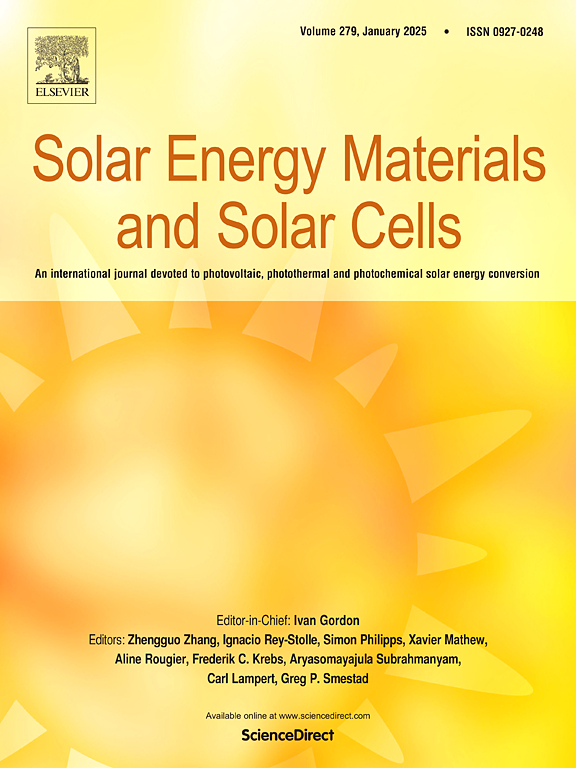HJT-IBC太阳能电池图案等离子体刻蚀工艺研究:保持高电子质量表面的关键
IF 6.3
2区 材料科学
Q2 ENERGY & FUELS
引用次数: 0
摘要
我们研究了一种涉及新型图案等离子体蚀刻步骤的电池制造工艺,以定义异质结(HJT)晶体硅(c-Si)太阳能电池的指间背接触(IBC)结构。在这个过程中,特定的等离子体表面处理是必要的,以获得良好的器件性能。使用x射线光电子能谱(XPS)和高分辨率透射电子显微镜(HRTEM)来研究这些治疗有效的潜在原因。探索了两种实验条件:(1)在沉积最终掺杂层之前,将氢化纳米晶硅(nc-Si:H)和非晶硅(a- si:H)层蚀刻至c-Si表面;(2)蚀刻后留下>; 5nm的本禀a- si:H (i-a-Si:H)。在第一种情况下,温和的NF3蚀刻步骤足以恢复没有s形的二极管样行为,但导致电池具有非常低的开路电压(VOC)。在第二种情况下,需要额外的H2等离子体清洁步骤来恢复没有s形的二极管样行为和良好的少数载流子寿命(和高VOC)。XPS分析表明,NF3蚀刻和H2等离子体都可以从图像化等离子体看到的界面上去除N, F和O,尽管对c-Si和a-Si:H表面的效果不同。关键的是,避免NF3蚀刻和H2等离子体之间的空气中断可以减少i-a-Si:H和最终掺杂层之间界面的氧化至背景水平,从而实现最佳器件性能。HRTEM提供了支持性的见解,解释了蚀刻步骤的必要性,以及在到达c-Si表面之前在i-a-Si:H层停止蚀刻的重要性。本文章由计算机程序翻译,如有差异,请以英文原文为准。
Investigation of Patterned Plasma Etching Processes for HJT-IBC Solar Cells: Keys to Maintaining a High Electronic Quality Surface
We examine a cell fabrication process involving a novel patterned plasma etching step to define the interdigitated back-contact (IBC) structure for heterojunction (HJT) crystalline silicon (c-Si) solar cells. In this process, specific plasma surface treatments are necessary to achieve good device performance. X-ray Photoelectron Spectroscopy (XPS) and High-Resolution Transmission Electron Microscopy (HRTEM) are used to investigate the underlying reasons for the effectiveness of these treatments. Two experimental conditions are explored: (1) etching the hydrogenated nanocrystalline silicon (nc-Si:H) and amorphous silicon (a-Si:H) layers down to c-Si surface before depositing the final doped layer, and (2) leaving a >5 nm intrinsic a-Si:H (i-a-Si:H) after etching. In the first case, a gentle NF3 etching step suffices to recover diode-like behavior without S-shape, but results in cells with very low open-circuit voltage (VOC). In the second case, an additional H2 plasma cleaning step is required to recover both diode-like behavior without S-shape and good minority carrier lifetime (and high VOC). XPS analysis reveals that both NF3 etching and H2 plasma can remove N, F, and O from the interface seen by the patterning plasma, although with different effectiveness for c-Si and a-Si:H surfaces. Critically, avoiding an air break between NF3 etching and H2 plasma reduces oxidation at the interface between i-a-Si:H and the final doped layer to background levels, thereby achieving the best device performance. HRTEM provides supporting insights that explain the necessity of the etching steps and the importance of stopping the etching at the i-a-Si:H layer before reaching the c-Si surface.
求助全文
通过发布文献求助,成功后即可免费获取论文全文。
去求助
来源期刊

Solar Energy Materials and Solar Cells
工程技术-材料科学:综合
CiteScore
12.60
自引率
11.60%
发文量
513
审稿时长
47 days
期刊介绍:
Solar Energy Materials & Solar Cells is intended as a vehicle for the dissemination of research results on materials science and technology related to photovoltaic, photothermal and photoelectrochemical solar energy conversion. Materials science is taken in the broadest possible sense and encompasses physics, chemistry, optics, materials fabrication and analysis for all types of materials.
 求助内容:
求助内容: 应助结果提醒方式:
应助结果提醒方式:


